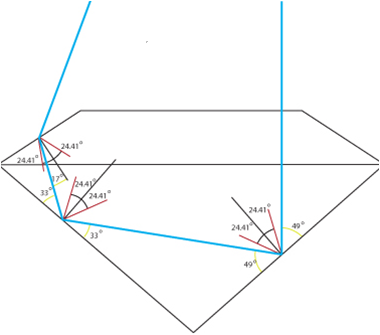Understanding cut grades allows a retailer to make informed decisions when purchasing diamonds and therefore buy better. It also allows a retailer to explain the cut grade of a diamond to a client in an authoritative manner.
Grading laboratories have differing criteria for cut grades, however there is commonality in reporting as far as cut grading is concerned. There are three main factors determining the cut grade of a diamond, namely:
- Proportions
- Symmetry
- Polish
Proportions
Since the time of Marcel Tolkowsky, a Polish diamond cutter from the early 1900s who was known as the father of modern round brilliant cut diamonds, proportions have been the foundation for the light performance of a diamond. I hasten to add that it is not to the exclusion of the other two factors, rather they all work in concert. The crown facets act as the windows through which light enters a diamond. The pavilion facets are the mirrors which reflect the light through the crown facets back to the viewer. The optical law, which is that the angle of incidence equals the angle of reflection, determines where facets are placed and at what angles in relation to each other. It follows logically that facets are dependent on one another to allow light to enter and exit a diamond; call it symbiosis for lack of a better word. By looking at the proportions tables of various laboratories, it becomes clear that steeper pavilion facets would require shallower crown facets, while shallower pavilions require steeper crown facets to offer the best light return.
The angle of incidence and reflection can clearly be seen in the image below. On the right side of the diagram the light ‘hits’ the pavilion facet at 40° and leaves the facet at 40°. The same is repeated on the left side where the light ‘hits’ the pavilion facet at 33° and leaves the facet at 33°. In both instances the light is reflected as the angles are greater than the critical angle, however, the light exits the diamond when the angle is less than the critical angle.

Symmetry
Symmetry is the accuracy of the placement of facets in a radial position as well as the accuracy of meet points on a diamond. On a round brilliant, the crown and pavilion mains are positioned 45° to each other, the upper and lower girdle facets are positioned 11.25° to their respective mains and 22.5° to each other. The star facets are positioned 22.5° from the crown main facets and 45° from each other. Furthermore, all facets within a facet group must be of identical size. Facet groups also must be the same distance from the table to produce a girdle that is parallel to the table as well as stars of equal length. Deviations in symmetry automatically lead to deviation of angles of facets, thus compromising the visual appeal of a diamond.
Polish
If all the preceding criteria are met, yet a diamond is not properly polished, it would compromise the light performance of the diamond. The facet surfaces must be free of wheel/polishing lines, abrasions, lizard skin, nicks, chips, burn marks and cavities. I would like to mention that diamond surfaces are anisotropic, meaning that there are harder and softer zones. More specifically, there are 14 locations at equally spaced three dimensional locations that would render facets unpolishable. These locations coincide with the octahedral faces and the cube faces. It is important for a diamond cutter to ensure that none of the facets would coincide with any of these 14 locations. Let us call them ‘dead spots.’ Even with their best efforts, some facets sometimes get very close or worse, coincide with these dead spots. A cutter could cheat the system by moving the facets ever so slightly off the dead spot to be able to cut and polish the facet, resulting in a diamond with compromised symmetry.
Low Scores
When it comes to grading, diamonds are penalized through a demerit system for any deviation in acceptable proportions, symmetry and polish. Sometimes a report may penalize a diamond but when viewing it, it does not look as bad as the report suggests, however there is always a reason why a diamond is demerited. With the advent of modern optical analysis machines, manual estimation has been taken out of the equation, resulting in more accurate reporting. Diamonds of acceptable proportions would for example score AGS 000 or GIA xxx if there are no demerits for symmetry or polish. The lowest score in any of the three criteria will determine the cut grade. This is the reason why triple excellent has become the new benchmark. The industry has already moved beyond the FTC guidelines and the question could be asked, rather must be asked: Where do we go from here? What is the next frontier we are going to challenge?
One thing will remain – a diamond will forever be only as good as its worse facet.


 RapNet Blog
RapNet Blog